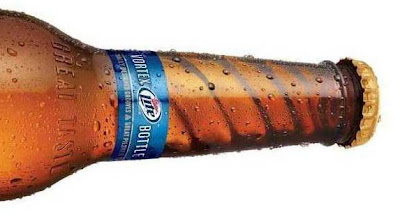Shotgunning, Inc.
More thoughts on beer technologies! These should go down just as smoothly as my post on canning craft beer (written up more fully here). I'll focus on MillerCoors, one of the industry's biggest packaging innovators, and in particular on one of their best-selling beers, Miller Lite.
 |
| Look at that pour! |
The fact that taste isn't the most interesting thing about Miller Lite (as the company itself has basically suggested*) is, I'd argue, not unrelated to the fact that the brand has been on the leading edge of a packaging revolution for the last half-decade.
Consumers have a lot of trouble telling the difference between "light American lagers" by taste (just listen to these experts!). To distinguish themselves on the marketplace, a lot goes into (big surprise) marketing – but here I think we've got something more. Differences in packaging might in fact be mostly talk, but there's at least a claim to technological superiority – and that's enough to get me interested.
Much recent design novelty is about getting the beer out of the bottle (and the alcohol into your bloodstream) faster and smoother, as can be seen in the brand's two most recent innovations.
The first is the "Vortex Bottle." Introduced in 2010, the "specially designed grooves inside the neck" are designed to let "the great pilsner taste flow right out."
 |
| The Miller Lite Vortex Bottle |
The second is the "Punch Top Can," which features "a second tab for a smoother pour." According to Miller Lite's "director of innovation and activation," the Punch Top is more popular than standard cans because "it’s more like drinking from a pilsner glass" (!).
 |
| The Miller Lite Punch Top Can |
Now, it seems pretty clear that similarity to "a pilsner glass" isn't the actual impetus behind the shift. Nor is it all that clear whether either innovation actually produces smoother (as opposed to faster) pours (though the Vortex has been subjected to rigorous experimental testing).
What's interesting to me is that, in the case of the Punch Top, what we have is a neat case of the corporate capture of subversive consumer behavior. The practice of "shotgunning," a favorite frat-boy pastime for decades, achieved the same effect with the addition of an outside technology (such as a pen or knife).
It seems like MillerCoors, in an effort to differentiate their product from identical competitors, has co-opted and attempted to monetize a longstanding traditional practice previously external to the market for the products themselves.
Two last points to make.
First, the whole thing about "pilsner glasses" makes clear that MillerCoors recognizes the danger in marketing alcoholic beverages on the basis of their "chuggability." Punch Tops are part of the continued effort of the manufacturers of "frat beers" to market their products without directly referencing the fun uses (flip-cup, keg-stands, funneling) to which they're put.
Second, what's on the one-hand an innovative corporate adaptation of a local practice is also a blast to the past in terms of beer containers. Remember church-keys? Time was, cans were all opened by "punching" – and featured instructions on the side for how to do it.
Punch Tops, too, carry instructions. The company even released a video detailing the advantages of their "new" packaging and how to navigate it.
In a final nod to the populist roots of their marketing ploy (and as a way to not-talk-about-but-not-not-talk-about its "chuggability"), the ad campaign for Punch Tops has emphasized not their smooth pour, but rather their customizability. "How do you punch it?"
What's interesting to me is that, in the case of the Punch Top, what we have is a neat case of the corporate capture of subversive consumer behavior. The practice of "shotgunning," a favorite frat-boy pastime for decades, achieved the same effect with the addition of an outside technology (such as a pen or knife).
 |
| Shotgunning the old-fashioned way |
Two last points to make.
First, the whole thing about "pilsner glasses" makes clear that MillerCoors recognizes the danger in marketing alcoholic beverages on the basis of their "chuggability." Punch Tops are part of the continued effort of the manufacturers of "frat beers" to market their products without directly referencing the fun uses (flip-cup, keg-stands, funneling) to which they're put.
Second, what's on the one-hand an innovative corporate adaptation of a local practice is also a blast to the past in terms of beer containers. Remember church-keys? Time was, cans were all opened by "punching" – and featured instructions on the side for how to do it.
 |
| Can Opening Instructions (from the 1930s) |
In a final nod to the populist roots of their marketing ploy (and as a way to not-talk-about-but-not-not-talk-about its "chuggability"), the ad campaign for Punch Tops has emphasized not their smooth pour, but rather their customizability. "How do you punch it?"
------------------------ ------------------------ ------------------------
*A recent ad contains a delightfully ambiguous line: "Because a guy that leaves no buddy behind deserves a beer that leaves no taste behind."


